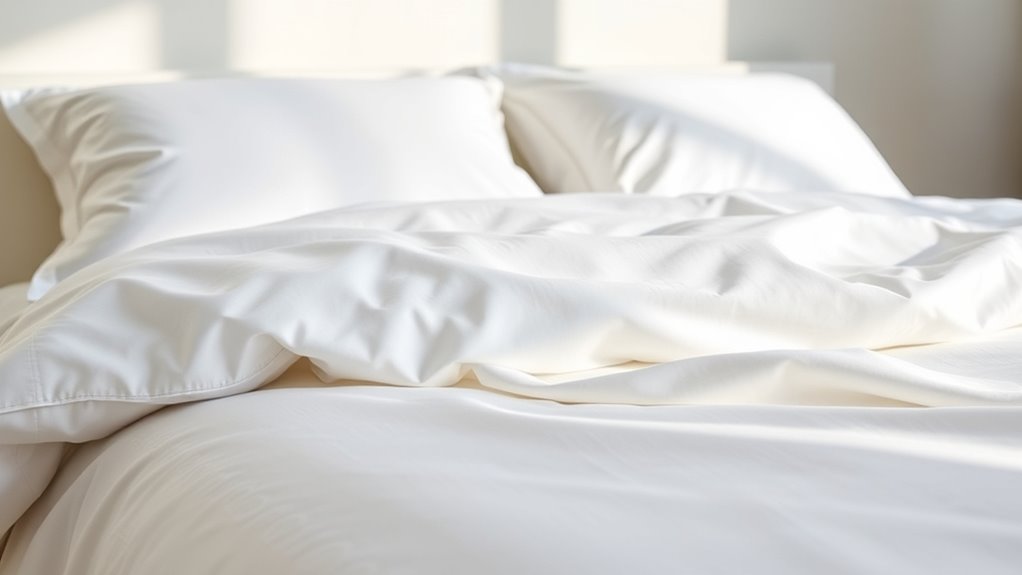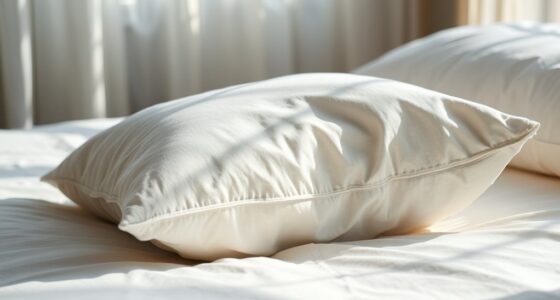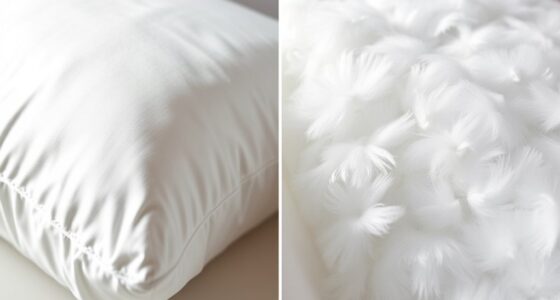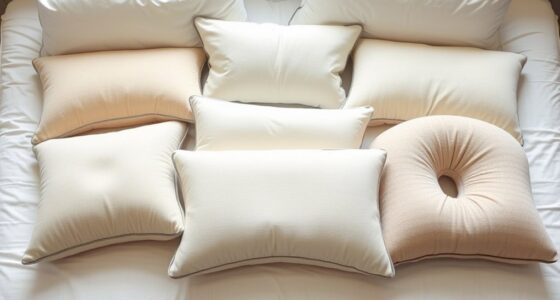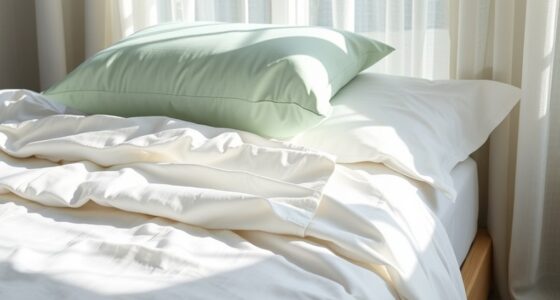Hypoallergenic bedding is designed to reduce your exposure to common allergens like dust mites, pet dander, and mold. It’s made from materials that resist allergens or are easier to clean, such as tightly woven fabrics or natural fibers like bamboo. To keep it effective, wash your bedding weekly in hot water and use allergen-proof covers. Maintaining a clean, dry sleeping environment further helps. Keep exploring to discover how to optimize your allergy-friendly sleep setup.
Key Takeaways
- Hypoallergenic bedding reduces exposure to common allergens like dust mites, pet dander, and mold, supporting healthier sleep for allergy sufferers.
- Made from materials such as synthetic fibers or bamboo, designed to resist or be easier to clean of allergens.
- Regular washing, airing, and maintenance help minimize allergen buildup and prevent mold and dust accumulation.
- Using allergen-proof covers and HEPA filters enhances barrier protection and air quality in the sleeping environment.
- Proper environmental controls like low humidity and clutter reduction further decrease allergen presence in the bedroom.
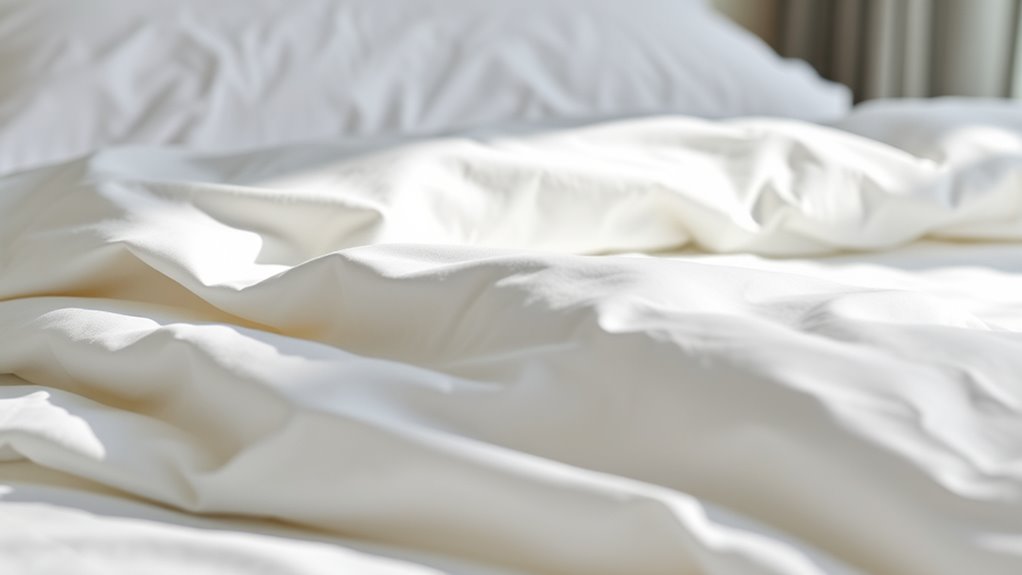
Have you ever wondered if your bedding could be contributing to allergy symptoms? Many people overlook how their sleep environment impacts their health, especially when it comes to allergies. Hypoallergenic bedding is designed specifically to reduce exposure to common allergens like dust mites, pet dander, and mold. Understanding how it works can help you make smarter choices for allergy prevention. The key is in bedding maintenance—regular cleaning and the right materials can drastically minimize allergen buildup.
When you choose hypoallergenic bedding, you’re selecting products made from materials that resist allergens or are easier to keep clean. For example, covers made from tightly woven fabrics create a barrier that prevents dust mites from burrowing into your mattress and pillows. This simple step can make a big difference in reducing allergy symptoms. But it’s not just about the initial purchase. Proper bedding maintenance is essential; washing your sheets, pillowcases, and mattress protectors weekly in hot water (at least 130°F or 54°C) kills dust mites and removes other irritants. Using allergen-proof covers consistently helps create a barrier that prevents allergens from accumulating over time.
Another important aspect of allergy prevention is choosing bedding that’s easy to care for. Hypoallergenic comforters and pillows are often made from synthetic fibers or natural materials like bamboo that are less likely to harbor dust mites or mold. Regularly air out your bedding during the day, especially in dry, sunny conditions, to reduce moisture that fosters mold growth. Avoid bringing in excess humidity, which can worsen allergy symptoms. Maintaining a clean sleeping environment also includes vacuuming your mattress periodically with a HEPA-filter vacuum, as this eliminates accumulated dust and skin flakes that serve as food for dust mites.
In addition to routine bedding maintenance, you should be mindful of the products you use. Avoid harsh detergents or fabric softeners, which can irritate sensitive skin or exacerbate allergies. Opt for gentle, hypoallergenic laundry detergents designed specifically for allergy sufferers. Keeping your bedroom clutter-free and maintaining a consistent cleaning schedule helps prevent dust accumulation. If you have pets, keep them out of the bedroom or at least off the bed, as pet dander is a common allergen. Also, consider using air purifiers with HEPA filters to reduce airborne allergens and improve overall air quality in your sleeping environment.
Frequently Asked Questions
Are Hypoallergenic Beds Suitable for All Allergy Types?
You might wonder if hypoallergenic beds suit all allergy types. While they’re designed to reduce dust mites and pet dander, some allergy sufferers may still experience symptoms. If you’re allergic to specific triggers like mold or pollen, a hypoallergenic bed can help but might not fully eliminate your reactions. It’s best to combine hypoallergenic bedding with other allergy management strategies for exhaustive relief tailored to your allergies.
How Often Should Hypoallergenic Bedding Be Washed?
Ever wondered how often you should wash your hypoallergenic bedding? The secret lies in maintaining its cleanliness to keep allergy symptoms at bay. For ideal results, you should wash your bedding weekly, following specific cleaning tips like using hot water and gentle detergents. This routine minimizes allergens and keeps your sleep environment fresh. Don’t underestimate the power of consistent washing frequency—it’s your best defense against lingering allergens and dust mites.
Can Hypoallergenic Bedding Prevent Allergy Symptoms Entirely?
While hypoallergenic bedding can substantially reduce your exposure to allergenic triggers, it can’t prevent allergy symptoms entirely. Regular bedding maintenance, like washing your sheets weekly and choosing allergen-proof covers, helps minimize allergens. However, individual sensitivities vary, so some symptoms may persist despite these efforts. Using hypoallergenic bedding is a helpful step, but combining it with other allergy management strategies offers the best chance to reduce your symptoms.
What Are the Best Materials for Hypoallergenic Bedding?
When choosing hypoallergenic bedding, you want fiber options that resist allergens like dust mites and mold, such as tightly woven cotton or silk. Look for fabrics with great durability, ensuring they hold up through frequent washing without losing their protective qualities. These materials help reduce allergy symptoms by creating a barrier against common irritants. By selecting the right fiber options and durable fabrics, you can enjoy a healthier, allergy-friendly sleep environment.
Is Hypoallergenic Bedding More Expensive Than Regular Bedding?
Imagine a delicate shield guarding your sleep—hypoallergenic bedding often costs more than regular sheets, but it’s worth the investment. The cost comparison varies, influenced by brand variations and materials used. While some options might seem pricey, they offer peace of mind and allergy relief. You’ll find that choosing hypoallergenic bedding is like selecting a gentle armor—protective and worth every penny, especially if allergies trouble your rest.
Conclusion
By choosing hypoallergenic bedding, you’re creating a sanctuary so pure, it’s like sleeping on a cloud of fresh snow. You’ll breathe easier, wake up refreshed, and enjoy a night free from sneezing fits or itchy skin. It’s not just bedding; it’s your personal shield against allergens and irritants. Make this simple switch today, and transform your sleep into a blissful escape—your health and comfort deserve nothing less than a heavenly, allergy-free haven.
